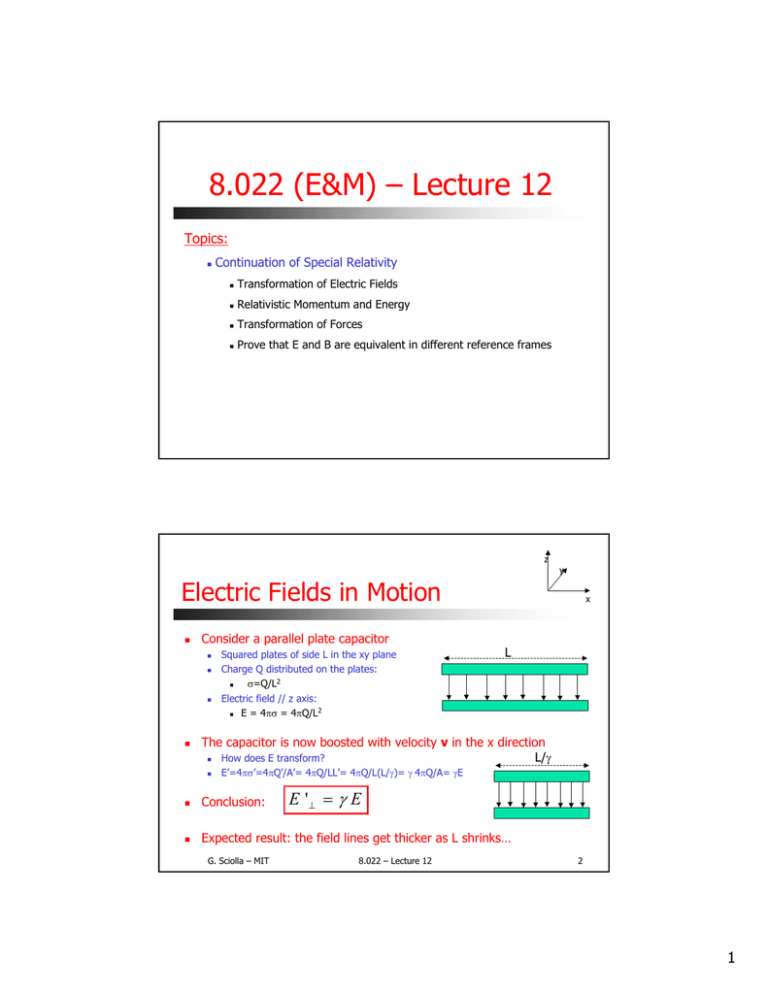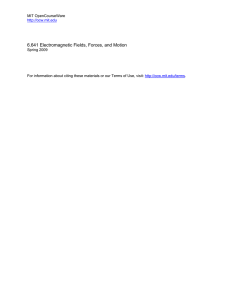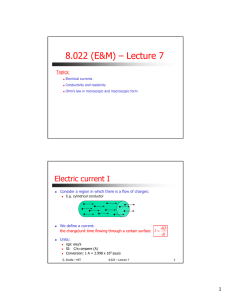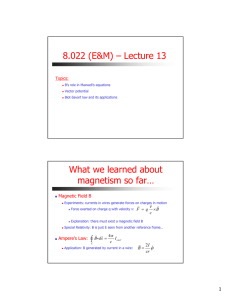8.022 (E&M) – Lecture 12
advertisement

8.022 (E&M) – Lecture 12 Topics: Continuation of Special Relativity Transformation of Electric Fields Relativistic Momentum and Energy Transformation of Forces Prove that E and B are equivalent in different reference frames z y Electric Fields in Motion Consider a parallel plate capacitor Squared plates of side L in the xy plane Charge Q distributed on the plates: σ=Q/L2 Electric field // z axis: 2 E = 4πσ = 4πQ/L x L The capacitor is now boosted with velocity v in the x direction How does E transform? L/γ E’=4πσ’=4πQ’/A’= 4πQ/LL’= 4πQ/L(L/γ)= γ 4πQ/A= γE E '⊥ = γ E Conclusion: Expected result: the field lines get thicker as L shrinks… G. Sciolla – MIT 8.022 – Lecture 12 2 1 z y Electric Fields in Motion (2) Now orient the capacitor with the plates in the yz plane: Charge Q distributed on the plates: σ=Q/L2 Electric field // z axis: 2 E = 4πσ = 4πQ/L L Boost again the capacitor with velocity v in the x direction x How does E transform? E’=4πσ’=4πQ’/A’= 4πQ/L’yL’z= 4πQ/A= E Conclusion: E ' // = E L Expected result: the field lines keep the same distance… How does the capacitance change? G. Sciolla – MIT 8.022 – Lecture 12 3 Momentum and Energy For a particle of mass m moving with velocity u Classical definitions: G G • M om entum : p = m u 1 • Kinetic energy: E kin = m u 2 2 Relativistic definition G G • Momentum: p = γ u mu • Energy: Why? See handout #2 E = γ u mc 2 where γu is the relativistic γ factor: γu = 1/(1-u2/c2) For low velocities, the new formulae reproduce old ones (Taylor!) 1 u2 G G G G • p = γ u mu ~ (1 + − ...) mu ~ mu 2 c2 1 u2 1 • E kin = γ u mc 2 ~ (1 + − ...) mc 2 ~ mc 2 + mu 2 2 c2 2 G. Sciolla – MIT 8.022 – Lecture 12 4 2 y ’ y Transformation of p and E z’ x’ x Consider 2 inertial reference frames: O and O’ O’ O z v O’ is moving w.r.t. O with velocity v // x axis How do momentum and energy Lorentz transform? One can demonstrate that ⎧ E ' = γ v ( E − β v cpx ) ⎪ p ' = γ ( p − β E / c) ⎪ x v x v ⎨ ⎪ p 'y = py ⎪p' = p z ⎩ z Sorry not today: no time! Where γu = 1/(1-βv2) and βv2=v2/c2 G. Sciolla – MIT 8.022 – Lecture 12 5 Transformation of Forces In an inertial R.F. O a force Fx is acting on a body of mass m Body is initially at rest: p=0 at t=0 Small acceleration Æ non relativistic velocities involved in O dpx dt 1 1 Fx • C h a n g e in p o s itio n : ∆ x = a ∆ t 2 = ∆t2 2 2 m • F o rc e F // to x a x is : F x = • C h a n g e in E n e rg y : ∆E = (∆ p ) 2m 2 = ( Fx ∆ t ) 2 2m How do these quantities look like in the Lab Frame O’? NB: O’ is moving with velocity v//x axis wrt the Frame O G. Sciolla – MIT 8.022 – Lecture 12 6 3 Forces // v How does Fx look in the Lab Frame O’ ? dp ' x dt ' R em em ber Lorentz transform ations: E ' = γ v ( E − β v cp x ) and p ' x = γ v ( p x − β v E / c ) F 'x = Fx 2 ∆ t ∆ [γ ( p x − β E / c ) ] ∆ p x − β ∆ E / c F x − β / c 2 m ∆ p 'x F 'x = = = = v v 1 Fx ∆t ' v ⎞⎤ ⎡ ⎛ ∆t − 2 ∆x ∆t 1− 2 ∆ ⎢γ ⎜ t − 2 x ⎟ ⎥ c c 2 m c ⎠⎦ ⎣ ⎝ For ∆ t → 0, this becom es: Conclusion: Fx 2 ∆ t 2m = F F ' x = lim F ' x = lim x ∆t → 0 ∆t → 0 v 1 Fx ∆t 1− 2 c 2 m Fx − β / c The component of the force // to vRF is constant: G. Sciolla – MIT F 'x = Fx 8.022 – Lecture 12 7 Forces perpendicular to v How does Fy look in the Lab Frame O’ ? F 'y = dp ' y dt ' R em em ber Lorentz transform ations: E ' = γ v ( E − β v cp x ) and p ' y = p y Fy ∆p y = v v 1 Fx ∆t ' v ⎞⎤ ⎛ ⎞ ⎛ ⎞ ⎡ ⎛ γ ⎜ ∆t − 2 ∆x ⎟ ∆t ⎟ γ ⎜1 − 2 ∆ ⎢γ ⎜ t − 2 x ⎟ ⎥ c c 2 m c ⎝ ⎠ ⎝ ⎠ ⎠⎦ ⎣ ⎝ Fy Fy F ' y = lim F ' x = lim For ∆ t → 0, this becom es: = ∆t → 0 ∆t → 0 F 1 v γ ⎛ ⎞ x ∆t ⎟ γ ⎜1 − 2 c 2 m ⎝ ⎠ F 'y = ∆p 'y = ∆p y = Conclusion: Components of force perpendicular to vRF are contracted: this–consistent G.IsSciolla MIT with what8.022 we–found about E? Lecture 12 F 'y = Fy γ 8 4 Please pay attention: this is difficult! Force by current on moving charge Description in the Lab Frame Electrically neutral wire carrying a current Positive charge density λ+= λ+REST= λ0. NB: these charges are at rest in O’ Negative charge density λ−= λ−ΜΟΤ= −λ0 NB: these charges are moving with velocity u −λ0 is not the density of the electrons in their reference frame O A charge Q outside the wire moves to right with velocity v Æ Q v charge Q + charges - charges G. Sciolla – MIT I 8.022 – Lecture 12 9 λ of negative charges in their RF We said: λ−= λ−ΜΟΤ= −λ0 What is charge density in their RF? λ0REST First attempt: Charge density λ0 = Q/L where L = length of the wire in Lab frame In lab frame: λ−ΜΟΤ = Q/L= -λ0 In O (in rest with - charges), length of wire appears contracted: L’:L/γ Æ λ−REST = Q/L’= Qγ/L= -γλ0 Æ λ−REST > λ −ΜΟΤ WRONG! Why? There is no such thing as the wire. Just the length of + and – charges which happen to be the same in the Lab reference frame but not elsewhere. Second attempt: The electrons will think: our length in our own RF is L’-. In the reference frame of the lab, boosted wrt us by a velocity –v, this length will be contracted by a factor γ: L’-= γL Æ λ−REST = Q/L-’= Q/γL= -λ0 /γ Æ λ−REST < λ −ΜΟΤ G. Sciolla – MIT 8.022 – Lecture 12 10 5 Force by current on moving charge What forces act on the charge Q? Lab frame: Wire is neutral: no electric filed E Current will generate magnetic filed B: Current in the wire: I=dQ/dt=λ dx/dt=λ u 0 0 Ampere’s law: B = 2I = 2λ0u cr cr v c Magnetic force acting on charge Q: F = Q B = Q 2λ0uv c2r Direction? Right hand rule: repulsive force NB: I opposite to v electrons! G. Sciolla – MIT 8.022 – Lecture 12 11 Force in charge’s rest frame? Let’s now move to the charges rest frame: charge Q + charges - charges Velocities involved: Charge Q: at rest by definition u−v Negative charges in the wire: velocity u’=(u-v)relativistic sum u ' = 1 − uv / c 2 Positive charges in the wire: velocity –v Is there any force acting on Q? There must be: Relativity Principle! No magnetic force: the charge is at rest! G. Sciolla – MIT 8.022 – Lecture 12 12 6 Charge densities in Q’s RF Are we in trouble? Let’s see what happens to the charges in the wire Positive charges: Charge density in charge’s reference frame: λ+’=Q/L’=γvλ0 Negative charges: ( − ) = -γ 1− β β λ −λ λ-'=γ u'λ- REST = γ u' 0 = γ u γ v (1− β u β v ) u v) 0 v( γu γu Goal: calculate γ u' . Let's start calculating 1/γ 2 u' = 1 − β 2 u' ⎛ u−v ⎞ 2 ⎜ ⎟ ⎛ βu − β v ⎞ 1 − 2βu β v + β u 2 β v 2 − (β u − β v )2 1− uv / c 2 ⎠ ⎛u'⎞ = = 1− ⎜ ⎟ = 1 − ⎝ = 1− ⎜ ⎟ = 2 c2 ⎝c⎠ (1− β u β v ) ⎝ 1 − βu β v ⎠ 2 2 1 − β 2 u' = (1 − β v 2 )(1 − β u 2 ) (1 − β u β v ) 2 = 1 γ uγ 2 2 v (1− β u β v ) G. Sciolla – MIT ⇒ 2 γ u' = γ u γ v (1− β u β v ) 8.022 – Lecture 12 13 Force in charge’s rest frame Net charge density in Q’s reference frame: λ 'NET = λ+ ' + λ-' = γ v λ0 - γ v (1 − β u β v ) λ0 = γ v β u β v λ0 = γ v In this RF there is a net charge on the wire! Æ Electric field! E'= 2λ 'NET r = γv 2uvλ0 rc 2 Electric field Æ force F’ will act on the charge Q F ' = QE ' = γ v uv λ0 c2 2Quvλ0 rc 2 (repulsive) Is there a Magnetic field as well? Yes, but it does not excerpts any force on Q because Q is at rest G. Sciolla – MIT 8.022 – Lecture 12 14 7 Comparison of forces in the 2 RFs In lab frame: Repulsive magnetic force acting on charge Q: 2λ uv v F = Q B = Q 20 cr c In Q’s rest frame: Repulsive electric force acting on charge Q: F ' = QE ' = γ v Q 2λ0uv c2r Are results consistent? Yes! We have seen that forces in direction perpendicular to v transform as Fy F 'y = G. Sciolla – MIT γ 8.022 – Lecture 12 15 Thoughts on this problem Is the comparison fair? No, on the contrary! In one RF we have a magnetic force, in the other an electric force Are we comparing apples and oranges? This results proves that Electricity and Magnetism are intimately connected! Physics is consistent! Principle of relativity demands that the 2 observers will come to the same conclusions The details of the calculation (Electric? Magnetic?) are different in the different RF, but ultimately irrelevant. G. Sciolla – MIT 8.022 – Lecture 12 16 8 Summary of Special Relativity Speed of light and physics are the same in all RF Consequences in mechanics Time dilation Length contraction Moving objects appear shorter along direction of motion: ∆L = γ ∆L’ Force transformation Moving clocks run slower ∆t’ = γ ∆t Components // v: constant; perpendicular to v: contracted: F ' y = Fy γ Consequences in E&M Pure B in one RF looks like E in another And vice versa, pure E in one RF looks like E+B in another Because there is a force even in the particle’s reference frame G. Sciolla – MIT 8.022 – Lecture 12 17 Outlook Today: Conclusion of Introduction to Special Relativity Transformations for momentum, energy and forces Proved that E and B are intimately connected Two observers, “relativistically” consistent results Next time: Back to Magnetism Ampere’s law, Biot-Savart, Vector potential G. Sciolla – MIT 8.022 – Lecture 12 18 9


